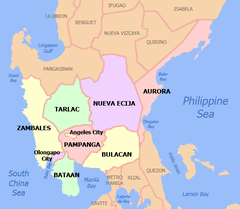Cabanatuan
| Cabanatuan | ||
|---|---|---|
| Component City | ||
| City of Cabanatuan | ||
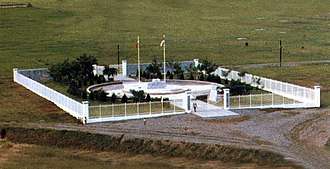   (clockwise): Camp Pangatian Memorial Shrine, Gen. Antonio Luna Equestrian Statue, San Nicolas de Tolentino Cathedral, Old Nueva Ecija Provincial Capitol, Camp Pangatian WWII Memorial | ||
| ||
| Nickname(s): Gateway to the North, Tricycle Capital of the Philippines | ||
| Motto(s): Pagbabago, Progreso, Disiplina | ||
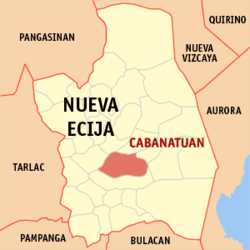 Map of Nueva Ecija with Cabanatuan highlighted | ||
.svg.png) Cabanatuan Location within the Philippines | ||
| Coordinates: 15°29′N 120°58′E / 15.48°N 120.97°ECoordinates: 15°29′N 120°58′E / 15.48°N 120.97°E | ||
| Country | Philippines | |
| Region | Central Luzon (Region III) | |
| Province | Nueva Ecija | |
| District | 3rd | |
| Founded | 1750 | |
| Cityhood | June 15, 1950 | |
| Barangays | 89 (see Barangays) | |
| Government [1] | ||
| • Type | Sangguniang Panlungsod | |
| • Mayor | Julius Cesar V. Vergara | |
| • Vice Mayor | Emmanuel Antonio M. Umali | |
| • Representative | Rosanna V. Vergara | |
| • Electorate | 201,995 voters (2016) | |
| Area [2] | ||
| • Total | 192.29 km2 (74.24 sq mi) | |
| Population (2015 census)[3] | ||
| • Total | 302,231 | |
| • Density | 1,600/km2 (4,100/sq mi) | |
| Demonym(s) |
Cabanatueños (Male), Cabanatueñas (Female), Cabanatuenean | |
| Time zone | UTC+8 (PST) | |
| ZIP code | 3100 | |
| PSGC | 034903000 | |
| IDD : area code | +63 (0)44 | |
| Climate type | Tropical monsoon climate | |
| Income class | 1st city income class | |
| Revenue (₱) | 1,500,358,316.23 (2017) | |
| Native languages |
Kapampangan Tagalog | |
| Website |
www | |
Cabanatuan, officially the City of Cabanatuan, (Tagalog: Lungsod ng Cabanatuan; Cebuano: Dakbayan sa Cabanatuan; Ilokano: Siudad ti Cabanatuan; Kapampangan: Lakanbalen ning Cabanatuan; Pangasinan: Siyudad na Cabanatuan; also known as Cabsy), or simply Cabanatuan City is a 1st class city in the province of Nueva Ecija, Philippines. According to the 2015 census, it has a population of 302,231 people,[3] making it the most populous city in Nueva Ecija and the 5th populous in Central Luzon.
The city is popular for being home to more than 30,000 tricycles, thus priding itself as the "Tricycle Capital of the Philippines"[4] and its strategic location along the Cagayan Valley Road has made the city a major economic, educational, medical, entertainment shopping and transportation center in Nueva Ecija and nearby provinces in the region such as Aurora and Bulacan. It has also earned the moniker "Gateway to the North".
Cabanatuan remained as Nueva Ecija's capital until 1965 when the government created nearby Palayan City as the new provincial capital. Nueva Ecija's old capitol and other government offices are still used and maintained by the provincial administration.
History

Cabanatuan was founded as a Barrio of Gapan in 1750 and became a Municipality and capital of La Provincia de Nueva Ecija in 1780. Cabanatuan is the site of the historical "Plaza Lucero" and the Cabanatuan Cathedral, where General Antonio Luna was assassinated by Captain Pedro Janolino and members of the kawit battalion. Cabanatuan lost the title of provincial capital in 1850 when the capital of Nueva Ecija was moved to San Isidro, another historic town. It was only in 1917, when the Administrative code was enacted, that Cabanatuan was restored as capital of the Province. However, in 1965, Congress created Palayan City, which has been the capital ever since.
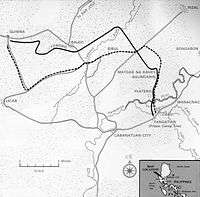
During World War II, the occupying Japanese built Cabanatuan Prison Camp, where many American soldiers were imprisoned, some of whom had been forced to endure the infamous Bataan Death March. In January 1945, elements of the U.S. Army 6th Ranger Battalion marched 30 miles (48 km) behind enemy lines to rescue the prisoners in what became known as the Raid at Cabanatuan. As a result of the raid on January 30, 1945, victorious Filipino guerrillas and American troops of the U.S. Army 6th Ranger Battalion celebrated having obtained the freedom of 500 American POWs. Soon thereafter, Philippine and American forces re-established the presence of military general headquarters and military camp bases of the Philippine Commonwealth Army, Philippine Constabulary 2nd Constabulary Regiment, and the United States Army in Cabanatuan from February 1, 1945 to June 30, 1946 during the Allied Liberation. Before long, the combined Philippine Commonwealth and American armed forces, in cooperation with local guerrilla resistance fighters and Hukbalahap Communist guerrillas, had liberated Central Luzon from Japanese Imperial forces, a campaign that lasted from January until August 1945.
In 1957, the barrios of Mataas na Kahoy, Balangkare Norte, Balangkare Sur, Sapang Kawayan, Magasawang Sampaloc, Talabutab Norte, Talabutab Sur, Platero, Belen, Pecaleon, Piñahan, Kabulihan, Pasong-Hari, Balaring, Pulong Singkamas, Panaksak, Bravo, Sapang Bato, Burol, Miller, Tila Patio, Pula, Carinay, and Acacia were separated from Cabanatuan and constituted into a separate and independent municipality known as General Mamerto Natividad.[5]
Cabanatuan was the epicenter of a very strong earthquake at roughly 3 P.M. on July 16, 1990. It leveled some buildings, including the Christian College of the Philippines (Liwag Colleges) in the midst of class time. At 7.8 on the surface wave magnitude scale, it killed 1,653 people.
Conversion from town, component city to highly urbanized city
Cabanatuan became a city by virtue of Republic Act No. 526, approved on June 16, 1950.[6] In 1998, Cabanatuan was declared by then-president Fidel V. Ramos as a highly urbanized city however it failed ratification after the majority of votes in the plebiscite was negative.
Cabanatuan was declared as highly urbanized city by President Benigno S. Aquino III under Presidential Proclamation No. 418 on July 14, 2012.[7] A plebiscite scheduled on December 2012 was moved by the Commission on Elections to January 25, 2014 so as not to burden the poll body during its preparation for the 2013 local elections in the province. Incumbent Governor Aurelio Matias Umali, who had a strong voter base in the city, opposed the conversion and submitted a petition to the Supreme Court. The Supreme Court issued a temporary restraining order on January 24, 2014.[8] On April 23, 2014, voting 9-5-1, the Supreme Court granted a petition for certiorari filed by Nueva Ecija Gov. Aurelio Umali and declared as null and void Comelec Minute Resolution No. 12-0797 dated September 11, 2012 and Minute Resolution No. 12-0925 dated October 16, 2012 setting a date for the conduct of a plebiscite in which only registered voters of Cabanatuan would be allowed to vote.[9] The province-wide plebiscite was rescheduled for November 8, 2014, but cancelled again because the Cabanatuan City government couldn't provide the funds needed for the plebiscite. No new date has been set until city government certifies that ₱101 million is available for the holding of the plebiscite.[10]
Geography
Cabanatuan City is located in the rolling central plains of Luzon drained by the Pampanga River. The city is seated 14 kilometres (8.7 mi) southwest of the provincial capital Palayan City and 120 kilometres (75 mi) north of Manila. The geographic coordinates of Cabanatuan City are 15° 29' 22 N, 120° 58' 14 E.
Climate
Cabanatuan has a tropical wet and dry climate (Köppen climate classification: Aw), with year-round warm weather and distinct dry and wet seasons. It is touted as one of the hottest cities in the country; in the summer season of 2011 Cabanatuan reached its hottest temperature at 39.8 °C, also the hottest in the Philippines in that same year, and on June 4, 2015 PAGASA reported a 53 °C (127 °F) heat index for the city, which is the hottest yet recorded.
| Climate data for Cabanatuan (1981–2011, extremes 1949–2012) | |||||||||||||
|---|---|---|---|---|---|---|---|---|---|---|---|---|---|
| Month | Jan | Feb | Mar | Apr | May | Jun | Jul | Aug | Sep | Oct | Nov | Dec | Year |
| Record high °C (°F) | 36.2 (97.2) |
38.1 (100.6) |
38.8 (101.8) |
39.9 (103.8) |
40.4 (104.7) |
38.5 (101.3) |
37.0 (98.6) |
36.0 (96.8) |
37.0 (98.6) |
37.1 (98.8) |
37.5 (99.5) |
36.5 (97.7) |
40.4 (104.7) |
| Average high °C (°F) | 32.1 (89.8) |
32.8 (91) |
34.3 (93.7) |
36.0 (96.8) |
35.6 (96.1) |
34.3 (93.7) |
33.0 (91.4) |
32.3 (90.1) |
32.5 (90.5) |
32.9 (91.2) |
32.7 (90.9) |
32.0 (89.6) |
33.4 (92.1) |
| Daily mean °C (°F) | 26.4 (79.5) |
27.0 (80.6) |
28.2 (82.8) |
29.8 (85.6) |
30.0 (86) |
29.4 (84.9) |
28.5 (83.3) |
28.2 (82.8) |
28.2 (82.8) |
28.2 (82.8) |
27.7 (81.9) |
26.8 (80.2) |
28.2 (82.8) |
| Average low °C (°F) | 20.6 (69.1) |
21.1 (70) |
22.1 (71.8) |
23.5 (74.3) |
24.4 (75.9) |
24.4 (75.9) |
24.1 (75.4) |
24.1 (75.4) |
23.9 (75) |
23.4 (74.1) |
22.6 (72.7) |
21.7 (71.1) |
23.0 (73.4) |
| Record low °C (°F) | 15.0 (59) |
15.0 (59) |
13.7 (56.7) |
15.8 (60.4) |
18.8 (65.8) |
19.9 (67.8) |
18.4 (65.1) |
19.0 (66.2) |
20.0 (68) |
18.6 (65.5) |
17.0 (62.6) |
15.1 (59.2) |
13.7 (56.7) |
| Average rainfall mm (inches) | 16.9 (0.665) |
16.6 (0.654) |
18.4 (0.724) |
47.4 (1.866) |
179.1 (7.051) |
193.7 (7.626) |
371.1 (14.61) |
372.0 (14.646) |
320.4 (12.614) |
186.4 (7.339) |
90.0 (3.543) |
42.9 (1.689) |
1,854.9 (73.028) |
| Average rainy days (≥ 0.1 mm) | 2 | 2 | 2 | 4 | 13 | 16 | 22 | 24 | 21 | 12 | 8 | 5 | 131 |
| Average relative humidity (%) | 82 | 80 | 79 | 77 | 80 | 86 | 89 | 91 | 90 | 87 | 85 | 82 | 84 |
| Source: PAGASA[11][12] | |||||||||||||
Barangays
Cabanatuan City is administratively subdivided into 89 barangays.[13]
- Aduas Centro (Aduas)
- Aduas Norte
- Aduas Sur
- Bagong Sikat
- Bagong Buhay
- Bakero
- Bakod Bayan
- Balite
- Bangad
- Bantug Bulalo
- Bantug Norte
- Barlis
- Barrera District (Poblacion)
- Bernardo District (Poblacion)
- Bitas
- Bonifacio District (Poblacion)
- Buliran
- Cabu
- Caudillo
- Calawagan (Kalawagan)
- Caalibangbangan
- Campo Tinio (Camp Tinio)
- Caridad Village
- Cinco-Cinco
- City Supermarket/Bayan (Poblacion)
- Communal
- Cruz Roja
- Daan Sarile
- Dalampang
- Dicarma (Poblacion)
- Dimasalang (Poblacion)
- Dionisio S. Garcia
- Fatima (Poblacion)
- General Luna (Poblacion)
- Hermogenes C. Concepcion, Sr.
- Ibabao-Bana
- Imelda District
- Isla (Poblacion)
- Kalikid Norte
- Kalikid Sur
- Kapitan Pepe Subdivision (Poblacion)
- Lagare
- Lourdes (Matungal-Tungal)
- M. S. Garcia
- Mabini Extension
- Mabini Homesite
- Macatbong
- Magsaysay North
- Magsaysay South
- Maria Theresa
- Matadero (Poblacion)
- Mayapyap Norte
- Mayapyap Sur
- Melojavilla (Poblacion)
- Nabao (Poblacion)
- Obrero
- Padre Burgos (Poblacion)
- Padre Crisostomo
- Pagas
- Palagay
- Pamaldan
- Pangatian
- Patalac
- Polilio
- Pula
- Quezon District (Poblacion)
- Rizdelis (Poblacion)
- Samon
- San Isidro
- San Josef Norte
- San Josef Sur
- San Juan Accfa (San Juan Poblacion)
- San Roque Norte
- San Roque Sur
- Sanbermecristi (Poblacion)
- Sangitan East
- Sangitan
- Santa Arcadia
- Santo Niño
- Sapang
- Sumacab Este
- Sumacab Norte
- Sumacab South
- Talipapa
- Valdefuente
- Valle Cruz
- Vijandre District (Poblacion)
- Villa Ofelia Subdivision (Villa Ofelia-Caridad)
- Zulueta District (Poblacion)
Demographics
| Population census of Cabanatuan | |||||||||||||||||||||||||||||||||||||||||||||||||
|---|---|---|---|---|---|---|---|---|---|---|---|---|---|---|---|---|---|---|---|---|---|---|---|---|---|---|---|---|---|---|---|---|---|---|---|---|---|---|---|---|---|---|---|---|---|---|---|---|---|
|
| ||||||||||||||||||||||||||||||||||||||||||||||||
| Source: Philippine Statistics Authority[3] [14] [15] [16] | |||||||||||||||||||||||||||||||||||||||||||||||||
Religion
Roman Catholicism has been the predominant religion in the city, being host to a major cathedral - the St. Nicholas of Tolentine Cathedral which serves as the seat of the bishop of the Diocese of Cabanatuan. There are three major Catholic structures located within the city, these are the Mother of Perpetual Help Parish, the Carmelite Sisters Convent and the Maria Assumpta Seminary. Local chapels/parishes are also present in most barangays.
Iglesia ni Cristo also maintains a sizable presence in Cabanatuan with its large house of worship in Brgy. Zulueta with a 5,000 persons seating inside. Jesus Miracle Crusade International Ministry (acronym as JMCIM) is an Apostolic Pentecostal religious group in the Philippines which believes particularly in the promotion of miracles and faith in God for healing. Jesus is Lord Church (JIL Church) is located at circumferential road.
The United Methodist Church also has many local churches with large number of congregations within the city. The United Methodist Church owns the Wesleyan University Philippines and the WUP-CMC Hospital.
Other Christian denominations also exist.
The Islamic faith also has a presence in Cabanatuan, specifically within the districts of Imelda and Isla. Two large mosques exist in the city, with the largest located at Imelda District.
Economy
Cabanatuan is the economic heart of Nueva Ecija. More than 640,000 people live in its metropolitan area comprising the city and its adjacent municipalities. As a hub, many people in Nueva Ecija commute to the city during the day. This causes the city's daytime population to swell to about a million.[17] Although Cabanatuan does not have significant manufacturing industries, its dynamic service sector together with the thriving agriculture drives the economy forward.
The city is a vital financial center housing a good number of banks, non-bank financial institutions and headquarters of some of the largest rural banks in Central Luzon. The Bangko Sentral ng Pilipinas (BSP) maintains a branch in the city that performs cash operations and cash administration. Approximately 39 billion pesos in deposit liabilities is kept in the city's 62 banks as of June 2017.[18] This amount constitutes more than half of the province's deposits. In terms of banking convenience, the city ranks as one of the most livable in the country together with Makati City.[19]
Cabanatuan Electric Corporation (CELCOR) generate electric power and distribute electricity to the Cabanatuan City. CELCOR main offices are located at Maharlika Highway, Barangay Bitas, Cabanatuan City. Collection offices are strategically located at CELCOR's Commercial Building in Burgos Avenue, Cabanatuan City and at the CELCOR's Commercial Building in Burgos Avenue, Cabanatuan City and at the Main Office in Bitas. First Cabanatuan Ventures Corp. (FCVC) 12.8 Megawatts Power Plant and First Cabanatuan Renewable Ventures Inc. (FCRV) 10.6 Megawatts Solar Power Plant to generate electric power to Cabanatuan City.
Globe Telecom, Smart Communications and Sun Cellular also have their business offices located in the city. The Philippine Long Distance Telephone Company (PLDT) have their business office at General Tinio St., while Digitel is in Mabini Extension. TV and Radio Stations are also present in the city.
The motor vehicle industry is a notable part of the city economy. Popular global automotive companies has established dealerships in the city's metropolitan area. Existing car/truck dealerships include Toyota (Toyota Cabanatuan Inc. being the 604th largest Philippine corporation[20]), Mitsubishi, Kia, Isuzu, Mazda, Ford, Nissan, Peugeot, Hyundai, Suzuki, and Mahindra, all in Cabanatuan; Foton and Honda in Santa Rosa town; Chevrolet and Hino in San Leonardo town. Motorcycle dealerships are common like in most Philippine mid-sized cities.
The city is also a distribution and logistics center for goods and commodities; a number of distribution warehouses and sales offices of various companies serve the whole of Nueva Ecija and parts of neighboring provinces. The NFA warehouses in the city play an important role in regulating Nueva Ecija's burgeoning rice industry. The city acts as a trading place or bagsakan of agricultural produce from the surrounding farming communities.
.png)
Indicators reflect Cabanatuan's economic achievements in the past few years.[21] Annual business registrations in the city grew 31.7% last 2015[22] while locally sourced taxes grew 14.81% annually in the five years to 2015.[23] Residential buildings and subdivisions, numbering more than a hundred, are taking up lands on the fringes of the downtown.
The presence of big land developers such as Sta. Lucia Realty, Vista Land and Ayala Land ensures competition and quality in the new suburban homes. New commercial buildings are springing up in the CBD and along Maharlika Highway on the average of seventy-five per year.
Cabanatuan nowadays is gradually becoming a major investment hub and is considered as one of the most competitive cities for doing business in the country. Investors in banking, real estate, retail and other business and industrial enterprises are similarly drawn to the city because of its adequate infrastructure and investor support services. Its continuing urbanization is also luring investors into its suburban municipalities as well.
To further explore its economic potentials, Cabanatuan is seeking to have a share of the IT-BPO boom. The first call center in Nueva Ecija was successfully established in the city in 2008. The city government is providing prospective investors fast business applications processing, low business taxes, and other incentives to attract big-ticket projects.[23]
In 2015, the city's total assets amounted to PHP 3.719 billion and the total income reached PHP 1.696 billion,.[24]
Real estate
Many Novo Ecijanos choose to resettle in Cabanatuan for proximity to job and other necessities. With the influx of people, residential developments followed and now more than a hundred subdivisions for A to D markets decimate the city.
Large-scale residential developments are present, such as Lakewood City and Avida Sta. Arcadia Estates. Sta. Lucia Realty's Lakewood City is a medium to high-end project encompassing more than 170 hectares. Its centerpiece is a 64-hectare championship golf course, one of the largest in Central Luzon.
Ayala Land's 87-hectare Avida Sta. Arcadia Estates is master planned to become a mixed-use development that will include the Avida Sta. Arcadia Residences, Avida Settings, and Avida Town Center.
Also included in the roster of large residential districts are the Kapitan Pepe Subdivision, Grand Victoria Estates, and Acropolis North by Sta. Lucia Realty.
Ayala Land currently has five residential subdivisions while Vista Land has three and Sta. Lucia Realty, three.
Recently, there is active development of residential subdivisions in Sta. Arcadia, Bangad and the stretch of NE-Aurora Road.
Prime lands in Cabanatuan are becoming pricier as demand for residential land props up with the entry of more Manila- and Cebu-based land developers.
Established players are being challenged by newcomers like Robinsons Land, SMDC, Filinvest and AboitizLand. SMDC's first horizontal housing development is currently under construction on a 25-hectare lot in Brgy. Sta. Arcadia.[25]
Shopping centers

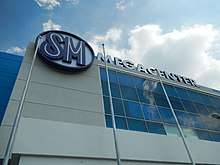
The shopping centers of Cabanatuan draw a lot of people from the province and nearby places. The downtown has three out of the six established malls: NE Mall, Waltermart and SM Megacenter. A fourth downtown mall will soon be built by Robinsons Land.[26] Another cluster of shopping malls can be found along Maharlika Highway south of the city center: NE Pacific Mall; Robinsons Townville, which is connected to NE Pacific Mall; and SM City Cabanatuan, the largest mall north of Metro Manila by gross floor area (154,020 sqm).[27]
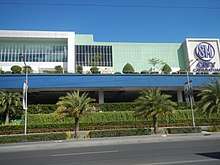
SM City Cabanatuan is built as a regional SM supermall. It features a garden park, a roof park, and the first ever SM Large Screen Cinema[28] in the country.
Other shopping centers include Savemore supermarkets, Puregold, a chain of NE supermarkets, and many small department stores.
The warehouse club store S&R opened recently, forming a sprawling shopping district with NE Pacific Mall and Robinsons Townville.
Vista Mall, CityMall and Robinsons Place are the upcoming malls in the city.
Hotels and restaurants
To date, there are 35 prominent hotels/motels/apartelles/inns, numerous resorts, and restaurants / fast-food outlets/nightclubs/disco houses.
Transportation
The city is a major hub of transportation services in Central Luzon. Cabanatuan City has a large number of bus companies operating provincial and regional routes, with the Cabanatuan Central Transport Terminal serving as the terminus. Jeepney operators serve routes within the province with some reaching as far to Dingalan, Baler and Dilasag in Aurora, Olongapo City, San Fernando and Dau in Pampanga, Mariveles and Balanga in Bataan, Baguio City in Benguet, Dagupan City and Tarlac City. Much of the city's population rely on public transportation such as tricycles and jeeps to get around the city.
Maharlika Highway (or Pan-Philippine Highway) is the main highway traversing the city where most vehicles going to Cagayan Valley pass through. Nueva Ecija - Aurora Road links Cabanatuan to Baler, Aurora, passing through rural towns in eastern Nueva Ecija. Burgos Avenue and Del Pilar Street serve as the city's main thoroughfare inside the downtown area. Other major roads include the General Tinio and Rizal Streets which run through the city proper in an east-west direction; Mabini Street, where two of the city's three universities are situated and the Circumferential Road that connects the downtown area to the Kapitan Pepe residential district. Two bypass roads were constructed during the early 2000s to decongest the Maharlika Highway and to spur new developments outside the downtown area. The 10.3-kilometer Felipe Vergara Highway provides a direct route to Cagayan Valley, while Emilio Vergara Highway links Santa Rosa to Nueva Ecija - Aurora Road, avoiding traffic bottleneck along Maharlika Highway.
Cabanatuan was served by the Manila Railroad Company way back in the 1900s through the Balagtas - Cabanatuan line and was later abandoned after the war when scavengers have looted pieces of the rail tracks. Rail service was later resumed in 1969 after the rehabilitation of the rail tracks as mandated by a government order, the service was again abandoned in the 1980s when the route didn't fare much to the commuters. The old Cabanatuan Railway Station is located at Barangay General Luna and is converted to a day care center with the original structure remaining.
Infrastructure improvements are ongoing with projects done by administration. All key intersections in the city are already signalized. Bicycle and tricycle lanes are currently being built while road widening of the Maharlika Highway from the present four lanes to eight lanes is on the drawing board. Road widening of all city and arterial roads from one/two-lane highway to three-lane highway is also being considered.
Two proposed expressways will pass through Cabanatuan City if built. These are the North Luzon East Expressway (Quezon City to Cabanatuan) and the Central Luzon Link Expressway (SCTEx-TPLEx to San Jose City).
Intercity/interprovincial buses from Manila serve the city, and are usually operated by Baliwag Transit, Inc., Five Star, Victory Liner, Genesis Transport Service Inc., GV Florida Transport, and Pangasinan Solid North. Jeepneys provide
Attractions
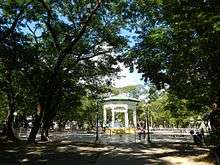
Historical sites found in the city include:
- Cabanatuan Railroad Station in Barangay General Luna, built in the early 1927 as the terminus of the now abandoned Balagtas-Cabanatuan line. The building has since been converted into a barangay civic center and day care center, with the original structure preserved.
- Camp Pangatian (Prisoner of War Memorial Shrine)(Now Cabanatuan American Memorial), began as a military training camp for twenty years until converted into a concentration camp for allied prisoners of war during the Japanese occupation. A popular tourist destination among war veterans by way of the WWII Veteran's Homecoming Program. Camp Pangatian's liberation of World War II American prisoners of war held by the Japanese forces in January 1945 was the most successful rescue operation ever executed by the American military aided by the Filipino guerillas who were fighting the invaders. That tactical operation was immortalized in the movie The Great Raid.
- Freedom Park is a provincial park located in front of the Old Provincial Capitol of Nueva Ecija, civic spaces as well as various monuments and memorials can be found inside the park which includes a monument dedicated to General Antonio Luna who was assassinated in the nearby Cathedral of San Nicolas de Tolentino.
- Gen. Antonio Luna Statue and Marker in Plaza Lucero, a statue of Philippine hero General Antonio Luna astride a horse stands at the plaza in front of the cathedral on the exact spot where the brave general was assassinated in 1899 in the city that adopted him subsequently.
- Old Provincial Capitol of Nueva Ecija located along Burgos Avenue, the old provincial capitol was designed by prominent American architect William E. Parsons who also designed government buildings in Manila, Cebu and Laguna during the American Colonial Period. The old edifice has since been renovated and expanded.
Festivals and celebrations:
- Banatu Festival celebrates its founding anniversary as a chartered city. From its humble beginning in 2015, "Banatu Festival" aims to showcase the history, culture, talent, beauty and craftsmanship of Cabanatueños.
- Longganisa Festival one of activities in "Banatu Festival" and is held in the vicinity of the public market along Paco Roman Street. Apart from the local meat traders and costumers, tourists from nearby town are also joining the celebration. Highlights of this festival are the cooking contests and the different preparations for longanisa (native sausage like "batutay", "longanisang bawang" and "longanisang matamis"), including spaghetti and “binagoongan”.
City Tourist Spot:
- Banatu Box Food Park the city's premiere food destination harboring different local entrepreneurs, Located M. De Leon Ave. Kapitan Pepe Subdivision.
Education
Cabanatuan is the one of the region's educational center being home to more than 40 higher education institutions, 1 science high school, more than 50 public and private high schools, and more than 100 public and private primary schools. Most of the students of the province go to Cabanatuan to study and build their career in the city.
Universities and colleges:
- ABE International College
- Acatech Aviation College
- AMA Computer College
- Asian College of Science and Technology
- Asian Institute of Computer Studies (AICS)
- Asian Institute of E-commerce (AIE)Cabanatuan
- Araullo University (Main Campus)
- Araullo University-South
- College for Research & Technology
- College of the Immaculate Conception
- Datamex Institute of Computer Technology - Cabanatuan City
- Dr. Gloria Lacson Foundation Colleges
- Eduardo L. Joson Memorial College (School of Scholars)
- First Asian International Systems College
- Good Samaritan Colleges
- Interface Computer College (closed)
- La Fortuna College
- Midway Maritime Foundation
- M.V. Gallego Foundation Colleges
- Nueva Ecija University of Science and Technology Sumacab (Main Campus)
- Nueva Ecija University of Science and Technology – General Tinio Street Campus
- North Central Academy for Culinary Arts
- Our Lady of Fatima University (Nueva Ecija Colleges)
- Philippine Statesman College
- Provincial Manpower Training Center
- St. Augustine Foundation College
- St. John Regis Health Care Institute Inc.
- Skill Power Institute
- Wesleyan University (Philippines)
Catholic seminary:
- Maria Assumpta Seminary
Health services
Many hospitals and clinics can be found in the city, most are private and with modern facilities which made Cabanatuan City the center for medical operations and research in the province. Most residents of the province go to Cabanatuan for their check ups and appointments in hospitals and clinics within the city.
List of Hospitals: (3) Public and (5) Private
- Dr. Paulino J. Garcia Memorial Research and Medical Center
- Eduardo L. Joson Memorial Hospital (Nueva Ecija Provincial Hospital)
- M. V. Gallego Cabanatuan City General Hospital
- Immaculate Concepcion Medical Center of Central Luzon
- Nueva Ecija Doctors' Hospital
- Nueva Ecija Good Samaritan General Hospital
- Premiere Medical Center
- Wesleyan University General Hospital and Cardiovascular Center
Sister cities
- Angeles City, Pampanga
- Tarlac City, Tarlac
- Quezon City, Metro Manila
- Baguio City, Benguet
- Taguig City, Metro Manila
- Davao City, Davao del Sur
- Cebu City, Cebu
- Manila, Metro Manila
- San Fernando, Pampanga
- Gapan City, Nueva Ecija
- Calamba City, Laguna
- Aliaga, Nueva Ecija
- Santa Rosa, Nueva Ecija
- Santa Rosa City, Laguna
Notable people from Cabanatuan
- Ameurfina Melencio-Herrera, Filipino lawyer and jurist who served as Associate Justice of the Supreme Court of the Philippines from 1979 to 1992. Herrera is a granddaughter of Emilio Aguinaldo.
- Willie Revillame, television host, actor, comedian and a recording artist grew up in Cabanatuan.
- Vic Sotto, Multi-awarded Filipino actor, television host, comedian.
- Cristy Fermin, showbiz reporter, talk show host, and journalist.
- Paolo Ballesteros, Filipino actor, TV host and model. He is also a mainstay host of Eat Bulaga
- Nestor de Villa, Filipino actor frequently cast in musical films. He was a gifted dancer, often paired with frequent on-screen partner Nida Blanca in both movies and television. His dancing talent led some people to call him the "Fred Astaire of the Philippines"
- Heber Bartolome, Filipino folk and folk rock singer, songwriter, composer, poet, guitarist, bandurria player, bluesman, and painter.
- Kathryn Bernardo, Filipina actress, singer and dancer. She is best known for her role as Mara in the primetime Filipino drama, Mara Clara.
- Ruel S. Bayani, Filipino film and television director, writer, producer, who is best known for directing movies like One More Try, and No Other Woman and co-directing television shows like Budoy, Kokey, Mula Sa Puso.
- Andrea Torres, Filipina actress, television host, dancer and commercial mode
- John Paul Lizardo, also known as Japoy Lizardo, is a Filipino taekwondo Asian Games bronze medalist, actor and commercial model.
- Yen Santos, filipina actress and dancer. Part of ABS-CBN's Star Magic. Has appeared in Growing Up, teleserye Pure Love and current teleserye Dream Dad.
- Samboy de Leon, Filipino professional basketball player who last played for the Star Hotshots of the Philippine Basketball Association (PBA). National Athletic Association of Schools, Colleges and Universities (NAASCU), where he was awarded the league MVP in 2014 played for CEU Scorpions.
References
- ↑ "City". Quezon City, Philippines: Department of the Interior and Local Government. Retrieved 30 May 2013.
- ↑ "Province: Nueva Ecija". PSGC Interactive. Quezon City, Philippines: Philippine Statistics Authority. Retrieved 12 November 2016.
- 1 2 3 Census of Population (2015). "Region III (Central Luzon)". Total Population by Province, City, Municipality and Barangay. PSA. Retrieved 20 June 2016.
- ↑ http://philippinetimesofsouthernnevada.com/news/the-philippines/ph-provinces/cabanatuan-city-remains-the-undisputed-tricycle-capital-of-the-philippines/
- ↑ "An Act to Create the Municipality of General Mamerto Natividad in the Province of Nueva Ecija". LawPH.com. Retrieved April 12, 2011.
- ↑ "An act creating the City of Cabanatuan". LawPH.com. Retrieved April 9, 2011.
- ↑ http://www.pcoo.gov.ph/issuances/issuances-proc/Proc418.pdf
- ↑ http://www.rappler.com/nation/47928-sc-issues-tro-cabanatuan-plebiscite
- ↑ http://www.gmanetwork.com/news/story/358023/news/regions/sc-all-nueva-ecija-voters-should-take-part-in-plebiscite-for-cabanatuan-as-huc
- ↑ Elmo Roque (February 10, 2015). "'Highly-urbanized' Cabanatuan still unratified". punto.com.ph. Punto! Central Luzon. Retrieved 17 March 2015.
- ↑ "Cabanatuan City, Nueva Ecija Climatological Normal Values". Philippine Atmospheric, Geophysical and Astronomical Services Administration. Archived from the original on 8 October 2018. Retrieved 8 October 2018.
- ↑ "Cabanatuan, Nueva Ecija Climatological Extremes". Philippine Atmospheric, Geophysical and Astronomical Services Administration. Archived from the original on 8 October 2018. Retrieved 8 October 2018.
- ↑ "Province: Nueva Ecija". PSGC Interactive. Makati City, Philippines: National Statistical Coordination Board. Archived from the original on 21 October 2013. Retrieved 21 October 2013.
- ↑ Census of Population and Housing (2010). "Region III (Central Luzon)". Total Population by Province, City, Municipality and Barangay. NSO. Retrieved 29 June 2016.
- ↑ Censuses of Population (1903–2007). "Region III (Central Luzon)". Table 1. Population Enumerated in Various Censuses by Province/Highly Urbanized City: 1903 to 2007. NSO.
- ↑ "Province of Nueva Ecija". Municipality Population Data. Local Water Utilities Administration Research Division. Retrieved 17 December 2016.
- ↑ "Archived copy". Archived from the original on 2014-02-02. Retrieved 2014-01-18.
- ↑ http://www.bsp.gov.ph/statistics/statrddlpbs.asp
- ↑ http://archives.newsbreak-knowledge.ph/2008/07/04/makati-cabanatuan-tagbilaran-are-rps-best-cities-to-live-in/
- ↑ http://www.bworldonline.com/assets/subscribe.php?id_subs=top1000
- ↑ http://www.smprime.com/building-boom-hits-cabanatuan
- ↑ http://www.competitive.org.ph/cmcindex/pages/historical/?lgu=Cabanatuan
- 1 2 http://www.businessmirror.com.ph/cabanatuan-enjoys-economic-boom/
- ↑ http://www.coa.gov.ph/index.php/local-government-units/2015/category/5879-cities?download=26278:region-iii
- ↑ http://www.philstar.com/business/2015/08/03/1483785/sm-prime-allots-p1-b-housing-venture.
- ↑ http://www.thestandard.com.ph/business/190186/robinsons-bullish-plans-10-new-malls.html
- ↑ http://www.sminvestments.com/sites/default/files/reports/9M%202014%20Results_11062014.pdf
- ↑ http://manilastandardtoday.com/2015/10/07/sm-opens-first-large-screen-cinema-in-cabanatuan/
| Wikivoyage has a travel guide for Cabanatuan. |
| Wikimedia Commons has media related to Cabanatuan. |

